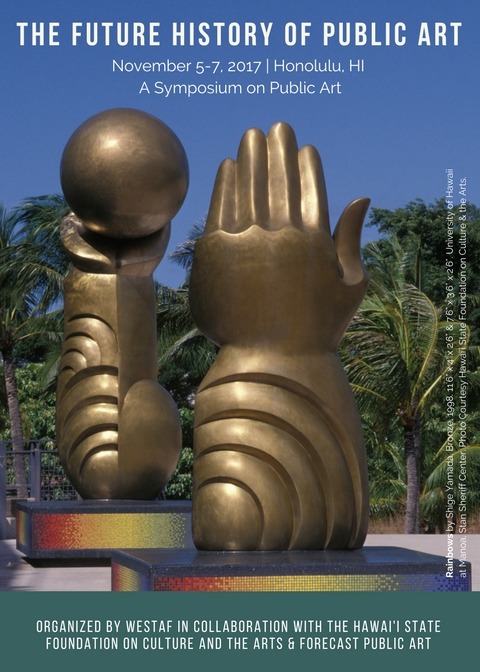We are pleased to announce additional details of WESTAF’s 17th symposium: The Future History of Public Art. This gathering of public art practitioners and allied professionals will convene November 5-7 in Honolulu and will take place at the Hawai’i State Art Museum. The symposium is being organized by WESTAF in collaboration with Forecast Public Art and the Hawai’i State Foundation on Culture and the Arts.
The symposium will bring together public art administrators, directors, artists, critics, curators, academics, and researchers to consider the future of the field. Participants, attending from across the globe, will survey growing trends and challenges and propose ways the field might develop to create a richer and more sustainable long-term infrastructure throughout the following sessions, outlined briefly below.

I. The Future Democracy of Public Art
Presenters will consider the current state of democracy in the processes of commissioning and selecting public art. They will address current realities and growing challenges surrounding issues of identity, development practices, and professional culture. Session participants will consider how practitioners might build a stronger and more inclusive infrastructure to promote equitable practices and engage more diverse audiences throughout the public art workflow.
II. The Future of Technological Advancements in Public Art
The use of advanced technologies has become increasingly widespread to instigate funding, data collection, increased participation, and efforts to improve the preservation of public art. Presenters will assess established practices and growing trends within the field’s integration of technology into public art programming. They will consider the relative merits of the incorporation of new media into mainstream programming while considering ways to build support frameworks to aid in more seamless and meaningful integration.
III. Public Art Stewardship: Methodological Approaches to Impact Studies
Access to established field-wide resources regarding public art evaluation remains limited. Presenters in this session will critically evaluate methodologies for data collection and impact studies to promote stewardship throughout the entirety of the public art process. They will survey resources invested toward documenting and analyzing the effects of public art and discuss how to better develop partnerships, tools, and interdisciplinary approaches for the success of future projects.
IV. The Re-Rise of Impermanence in Public Art
Presenters will examine the recent increase of public art projects and programs meant for temporary installation. They will evaluate the varied roles and audiences that temporary public art activities serve and how they may continue to play a pivotal role in the future of the field. This session will survey new approaches to planning, advocacy, funding, and collaboration alongside a review of how stakeholders might adopt measures to support this model.
V. Re-thinking Public Art Policy & Funding Mechanisms
Presenters will survey the current landscape of public art policy and funding mechanisms and analyze challenges and limitations associated with existing policies. They will explore emerging models that have circumvented obstacles and instigated new forms of private and public support. Participants will convey specific experiences that bypass more traditional approaches and art seemingly less susceptible to bureaucratic red tape, and they will discuss the efficacy of these approaches in the future.
The symposium will be preceded by a public art workshop developed and led by Forecast Public Art with support from the Hawai’i State Foundation on Culture and the Arts and WESTAF. The workshop is scheduled for Sunday, November 5, from 11:00 am to 3:30 pm. The workshop will be focused on sparking conversations about the current concerns of practitioners and collaborators in the field. The session is designed to be an interactive discussion drawing questions and topics from the group with the hopes of a lively and fun afternoon of networking and sharing. Questions posed in the workshop may range from advocacy and engagement, racial equity and inclusion, best practices for community engagement, tools for broadening policy and funding mechanisms, public art in the media, and ways to increase opportunities for professional development. The workshop is available at no cost to registered symposium observers.
Observers are encouraged to attend the symposium; however, space is limited. Observers are responsible for covering the cost of their travel and lodging. In addition, they are asked to pay a $185 fee to underwrite costs of meals included in the event. Please note that observers are not part of the core symposium conversation. Those interested in observing the symposium must register by Friday, September 15. Registered observers will be notified via email by Friday, September 22, and will receive additional details regarding their participation at that time. As with all previous WESTAF symposia, this gathering will have a life beyond the in-person meeting. As part of the symposium process, WESTAF prepares and publishes the symposium discussion in the form of proceedings. The proceedings will also be made available on the WESTAF website.
If you have any questions about the symposium, please contact Lori Goldstein at Lori.Goldstein@WESTAF.org or (303) 629-1166.
